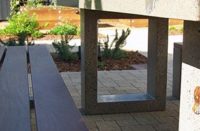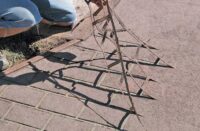Concrete is a remarkable material with origins stretching back to antiquity. Concrete and its primary ingredient, cement, have changed a lot over the years, but the following timeline helps bring the history of this important material into the present day.

1 Cement goes back to ancient Greece and Rome, where Greeks and Romans used lime and volcanic ash that reacted with water to form a hard mass. This was used in Roman construction some 2,000 years ago. The Romans also gave cement its name — it is derived from the Latin word caementum, which meant the stone chippings used in Roman mortar.
2 In A.D. 125 Rome’s Emperor Hadrian oversaw the completion of the Pantheon, a circular concrete building with a large, unreinforced concrete dome that’s 142 feet in diameter. It rises to a height of 71 feet and has a 27-foot hole, called an oculus, at its peak, which is 142 feet above the floor. The dome has held because of the careful selection and use of aggregate — heavy basalt is used on the outer edges while the lightest pumice is used toward the center.

3 The process for making portland cement is patented in 1824 by an Englishman named Joseph Aspdin. He burned a mixture of limestone and clay or shale in a kiln and then finely ground it. The name portland comes from the limestone found on a British peninsula called the Isle of Portland.
4 The patented invention of steel-reinforced concrete in 1867 is usually attributed to Joseph Monier, a Parisian gardener who made garden pots and tubs of concrete reinforced with iron mesh.
5 In 1891 the first concrete street in the United States was poured in Bellefontaine, Ohio.

6 The process for prestressed concrete, which reinforces strength through compression, was developed by the French engineer Eugène Freyssinet in the early 20th century.
7 In 1913, the first load of ready-mix was delivered to a building site in Baltimore, Maryland.

8 In the 1950s, Brad Bowman of Carmel, California, began imprinting individual brick patterns onto concrete using wooden blades. He continued refining the Bomanite Imprint Systems, as the cast-in-place, colored, textured and imprinted architectural concrete paving system was called, until 1970 when the Bomanite Corp. was established.
9 Jon Nasvik expanded on Brad Bowman’s idea and in the late 1970s developed the first urethane stamps that imprinted both pattern and texture on fresh concrete. Today, textured and patterned stamps are standards in our industry.

10 As Southern California contractors, Rod Sadleir and his brother, Gerry, were among the first to resurface concrete with a very thin polymer-cement overlay. At World of Concrete in 1997, they unveiled their 1/4-inch-thick stamped concrete overlay. In 2001 Gerry developed Spray-Top, a revolutionary polymer-modified cement that can be sprayed over stamped concrete surfaces for restoration without losing the stamped texture. It also provides a surface that is uniform in color for dyeing or acid staining. Additionally, Gerry developed a new system for Spray-Top called Roll-Top which performs similarly except it can be rolled on instead of applied with a special sprayer.















